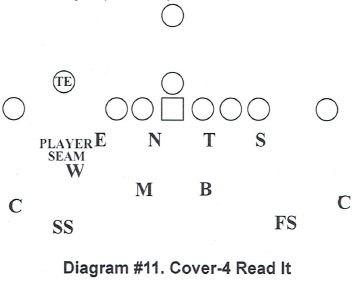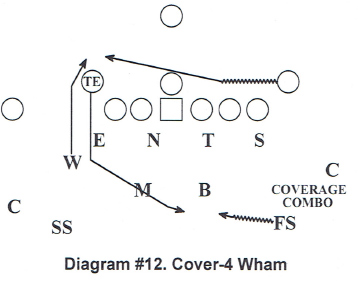|
Cover-4 from the 4-2-5 Defense By: Aaron Segedi- Trenton High School (MI) Originally Published - Nike 2015 Coach of the Year Clinic Notes - Earl Browning - nikecoyfootball.net
I want to give you a little background about our school. We have a student population of around 1200 students. There are eight divisions of school in Michigan. Eight is the lowest division and we are a three division team. We are not a school of choice. That means we have the players that attend that school. We coach the kids we get. In the 14 years I have been there we have done a good job of keeping our players active in our program. We have all levels and abilities. The players that are academically challenged pick up on what we teach. The things we install in the spring and summer are the things we will play in the state championships next year. We do not add something new every week. It becomes more difficult for the players to understand if you do that. I heard some coach say this today and I think it is extremely true. We know more than the players, but the players have to play the game. It is not what we know, it is what the players know. If the players are comfortable and know how to do things, that is a win-win situation. It must be simple. If they are thinking we will lose. Playing defense is more of a reaction. Our cover-4 is a little different than what Michigan State plays. We do not have the athletes to press up on the receivers all the time. • We get 9 defenders in the box against the run We looked hard at cover-3 but we felt cover-4 fit our personnel better. This coverage allowed us to play all the offensive scheme we see today and be most effective. The fact that it can be taught in a short period is huge. You teach the rules and you can reinforce them throughout the season.
I know not many of you see a Pro-I-formation any more but that is a good starting point for our teaching. In our scheme, the Will linebacker is the hybrid player. He plays into the field most of the time. He is the force and flat defender. (Diagram #1) The rule exception is a two displacement rule, which I will cover later. In that case he goes to the boundary side of the defense. In this coverage, the weak side flat is an issue. Our corner aligns at six yards with inside alignment on the number-1 receiver. He takes care of the verticals and plays the 7, 8, and 9 routes (corner, post, takeoff) by the wide receiver. We handle the underneath patterns with the Will linebacker. He plays the hitches and speed outs. We align the safeties at eight yards. To the boundary we have an issue with the 3-step quick passing game.
The Mike linebacker runs to the playside and fits inside the scraping linebacker. The free safety replaces the Mike linebacker and becomes the cutback player. If the ball is a full flow play with the ball going outside and no threat of cutback, the free safety uses a conventional pursuit angle across the formation instead of replacing the Mike linebacker for the cutback. The strong safety is the alley runner on the play. The playside corner arrives late and is the secondary force. The backside corner gets into his proper pursuit angle. We want to attack the ball carrier on his backside hip. That prevents the ball from cutting back on the tackler. We have three teams going and work the drill rapidly. We work both sides of the formation. The run fits on an inside run are similar. The Will linebacker reads the down block by the tight end and becomes the force player. (Diagram #3) The strong safety fills inside the Will linebacker. The Backer linebacker has a tight scrape because of the angle of the football. The Mike linebacker fills the strong side A-gap. The free safety replaces the Mike linebacker and becomes the cutback player. To the weak side of the formation is where we have some run and pass issues. We talked to the Mount Union coaches and they gave us a clue of how to best play the weak side of the formation. It was hard for the free safety to be the force player with an eight yard The Will linebacker has a "vice" rule on flow away. (Diagram #4) He is not running to the weak side. He is playing back side for anything coming back. We feel the biggest runs in the running game are the cutback runs. The Will linebacker is there to stop those kinds of runs. The free safety is the force player to the weak side. The Mike linebacker becomes the scrap player and the Backer linebacker plays the weak side A-gap. In our pass reads we have rules we use to get us into our coverages. Pass Reads • Sky call needs to be made by corners and safeties The sky call tells the safety and corner to that side that they are playing cover-4. If the tight end takes an inside release up the field, we are in man coverage. The corner plays the number-1 receiver and the safety has the tight end. If the tight end releases outside, we go to a full matchup-zone coverage. That is what we get with spread teams in 2 X 2 formations. The rule is the corners play number-1 and safeties play number-2 unless they cross sidewalks. That means if the number-2 receiver goes outside or inside, the safeties give that receiver to the Will linebacker or the Backer linebacker and he looks for the new number-2 receiver, which generally is the number-1 receiver being played by the corner.
With a twin's formation, the coverage is cover-4 with a full matchup scheme. (Diagram #5) The corner, strong safety, and Will linebacker read the number-2 receiver. The strong safety's run key is the end man on the line of scrimmage (tackle). To the back side with no detached receiver, the corner and free safety run an inside/ out combo coverage. If the tight end releases vertical up field, the free safety takes him. If he releases outside, the corner takes him. The only time that rules does not hold true is when the tight end is on the back side of a trips set. In that case, the safety is going over the top to the trips side and With the trips formation and a single split receiver back side, we make a "bounce call." (Diagram #6) The corner to the single receiver side is on his own. He has that receiver man-to-man. I take my best defender and lock him on the single receiver. I do not have a boundary and field corner, I take the best athlete and coverage defender and put him on the single receiver. The Will linebacker is the trips side flat player. The Backer linebacker can take a deeper drop than normal because he does not want to get into the Will linebacker zone. The Mike linebacker is to the backside of the play. He has the running back if he swings out of the backfield to the backside. We have a call that can put the defensive end on the running back. If the end gets an "easy" call that means he is to feather his rush. He can help on the screen game or the back out of the backfield. If the back leaves, the end takes him, the Mike linebacker can blitz the B-gap, and play contain.
We can make a "solo" call with a trips formation. (Diagram #7) This helps the corner playing the single receiver. The "solo" tells the corner, he has to play between the number-1 and number-2 receivers if they both go vertical. The strong safety aligns on the number-3 receiver and has to take him if he goes vertical. The free safety takes his alignment off the remaining back in the backfield. If he aligns to the single receiver side, the free safety may want to walk down to play the speed option. If they put the back to the trips side, he can move more to support on the single receiver. If they run the jet sweep, he is in position to get up to make that play. He can also play over the top of the man-coverage. That protects the corner who may not be as good an athlete as the single receiver. Most teams put their best receiver at the single receiver position. Another way to play the trips set and help the corner in man coverage is called "exchange." (Diagram #8) We give the bounce call which moves the free safety to the number-3 receiver to the trips side. The "bounce exchange" call applies to the defensive end to the single receiver side. If the end gets a high-hat read from the offensive tackle, he drops under the single receiver. The Mike linebacker becomes the contain rusher blitzing through the B-gap. If the defensive end gets a down block from the offensive tackle, he plays run and applies his technique for a down block. If the offensive tackle tries to reach him, he The only time he is going to help is a true high-hat pass set by the offensive tackle. He will never be able to be a true underneath player on the number-1 receiver, however, he can make the quarterback elevate the ball to get it over his drop. That gives the corner time to react and make a play on the ball. I want to get into our "hot" calls. (Diagram #9) When we go to a "hot" call we are playing a split coverage. We play a "sky" call to the call side and a "hot" call to the back side. "Hot" coverage puts the free safety and corner in man coverage. The free safety can cheat in the box to help with run support. We can place the free safety anywhere we want.
If the number-2 receiver runs the shallow under the linebackers, he will run into the Will linebacker's coverage. If he goes high behind the linebackers, the free safety has him all the way. Cover-4 Read It Rules • The corners and safeties still key the number-2 receiver With 11 personnel in the game, we play the "read it" call. (Diagram #11) The corner to the tight end side aligns on the number-1 receiver and he may look like a cover-4 corner. However, he is about 4 to 4.5 yards off the ball with outside leverage on the number-1 receiver. He is more of a tilted corner and is going to squat and read the tight end (number-2). There was a vulnerability to the quick passing game. Teams could dink-and-dunk us all the way down the field. The corner sinks into his coverage as long as no one threatens the flat. If the tight end ran to the flat, the corner jumped the pattern. The free safety and strong safety plays over the top of the corner. The Will linebacker has no responsibility in the flat but carries the number-2 receiver up the seam walling him to the outside. The strong safety is over the top of both defenders. We play some wing-T teams and this is a good adjustment for them. (Diagram #12) To the tight end side of the formation we play a combo coverage on the tight end and right halfback. If he goes in jet motion to the other side, we tell the Will linebacker he has the motion man. He wants to get up the field and stop him in his tracks. As the motion back leaves in motion, the free safety starts to move with him. He is looking for the crossing pattern from the play side winged tight end. A coaching point for our safeties is to take a rocker step. That means he does not move both feet. He steps back with his outside foot. but does not move the inside foot, therefore he has not lost any ground. He steps back with his rocker step and reads. If he needs to come forward, he steps with his rocker step foot forward. He is not shuffling back where he has to plant and come forward. He rocks back on one foot and steps with the next foot the direction he has to go. This keeps them from false stepping. We have a saying that if you do not know, you do not go. Do not guess where the ball is going. When teams try to run the ball on us, we want to wrong arm and spill things to the outside. In the secondary I want the players to be comfortable in the way they play. If they can back pedal we do that, and if they can shuffle better we do that. I am involved with a special need organization for kids with special need. I encourage you to be a coach for life. We work with them and teach them more than just football. I am not only a liver transplant patient but also a two time cancer survivor. I have come face-to-face with dying more than once which has forced me to realize that this thing called "life" isn't just about me. When it comes to health, it takes a lot to knock me down. Each time I get back up, and have developed a deeper passion and a deeper feeling of the need to give back and pay it forward! I am the creator of Victory Day which debuted in the fall of 2010. Whether scoring a touchdown,. playing with the band or cheering with the cheer-leaders, this two hour event gives children with cognitive and/or physical impairments their Moment in the Sun on the football field! Victory Day has received national attention from Nike and the Huffington Post. Former head coach from the University of Michigan. Lloyd Carr has been the key note speaker each year. My ultimate goal is to inspire coaches all around this country to host their own Victory Day! I appreciate you time and thanks for having me today.
|
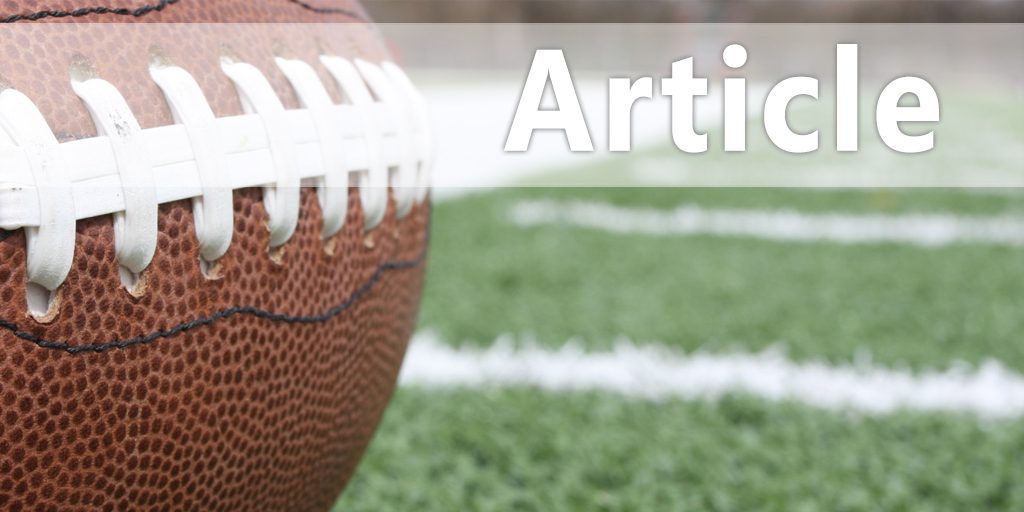


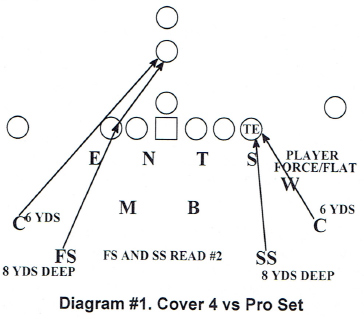 Our players are not the passionate players that absorb everything in a meeting type teaching session. They prefer to go on the field and walk through it. After the walk through you must rep it repeatedly. We can stem into another coverage easily. If the quarterback looks at the two high safeties he thinks he can throw the hitches and quick game. We have a coverage we can go to that is simple. We can become a cover-2 type coverage with a squat corner.
Our players are not the passionate players that absorb everything in a meeting type teaching session. They prefer to go on the field and walk through it. After the walk through you must rep it repeatedly. We can stem into another coverage easily. If the quarterback looks at the two high safeties he thinks he can throw the hitches and quick game. We have a coverage we can go to that is simple. We can become a cover-2 type coverage with a squat corner.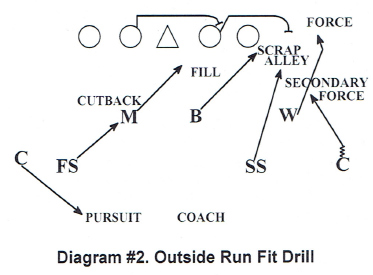 Before we did anything with formations, we wanted to teach our run fits. We do this in a fit drill. (Diagram #2) We align with a cone representing the center. We have two guards and two tackles in the drill. We work with the three linebackers, two safeties, and two corners as the defensive unit. The first fit is an outside run fit. The coach sets the play and gives the cadence. The offensive guards pull and the tackles cut off. This is a dummy drill and can be done without pads. The Will linebacker is the force player and sets the corner. The Backer linebacker is the scrape player to the run side and scrapes to the C-gap.
Before we did anything with formations, we wanted to teach our run fits. We do this in a fit drill. (Diagram #2) We align with a cone representing the center. We have two guards and two tackles in the drill. We work with the three linebackers, two safeties, and two corners as the defensive unit. The first fit is an outside run fit. The coach sets the play and gives the cadence. The offensive guards pull and the tackles cut off. This is a dummy drill and can be done without pads. The Will linebacker is the force player and sets the corner. The Backer linebacker is the scrape player to the run side and scrapes to the C-gap.
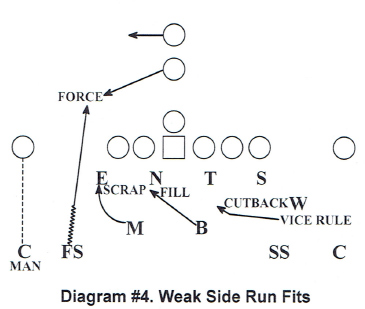 deep alignment. The coaches at Mount Union roll him down to linebacker depth and play man-coverage on pass. We put our best corner to the boundary side and locked up man-to-man with the wide receiver and rolled the free safety down.
deep alignment. The coaches at Mount Union roll him down to linebacker depth and play man-coverage on pass. We put our best corner to the boundary side and locked up man-to-man with the wide receiver and rolled the free safety down.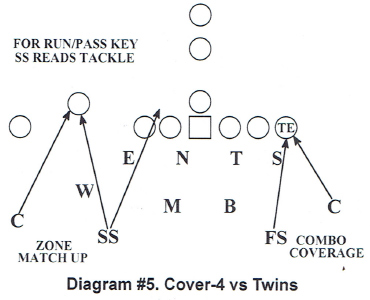 The problem occurs with the lock call. We tell the defenders, if the route goes past 10 yards to lock up man-to-man. The gray area comes in the 8-10 yard area. We tell the defender to give the lock call if he is not sure. If he gives the lock call at eight yards and the receiver runs an out at 10 yards, the safety has to play the out route.
The problem occurs with the lock call. We tell the defenders, if the route goes past 10 yards to lock up man-to-man. The gray area comes in the 8-10 yard area. We tell the defender to give the lock call if he is not sure. If he gives the lock call at eight yards and the receiver runs an out at 10 yards, the safety has to play the out route.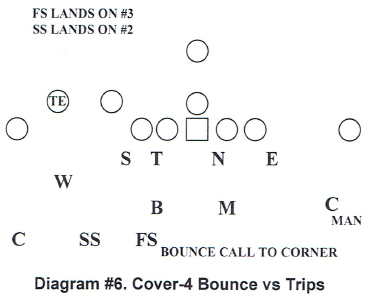 the corner works the combo with the Mike linebacker.
the corner works the combo with the Mike linebacker.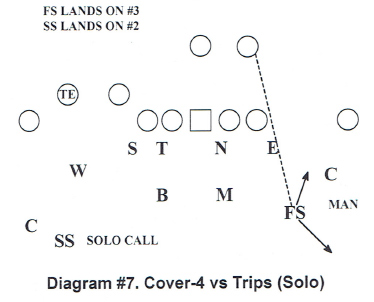 In the secondary, the free safety comes over the top and has the number-3 receiver on a vertical route down the middle. The strong safety takes the number-2 receiver if he goes vertical and the corner is on the number-1 receiver vertical. We want to disguise the coverage and move the free safety late.
In the secondary, the free safety comes over the top and has the number-3 receiver on a vertical route down the middle. The strong safety takes the number-2 receiver if he goes vertical and the corner is on the number-1 receiver vertical. We want to disguise the coverage and move the free safety late.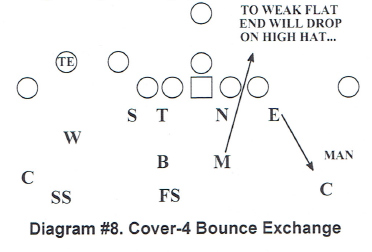
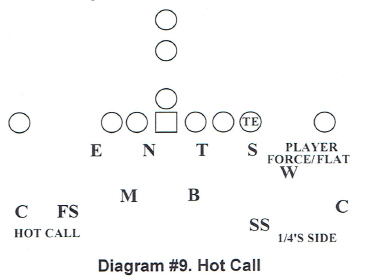 plays that block as a run blocker and uses his proper technique for that block.
plays that block as a run blocker and uses his proper technique for that block.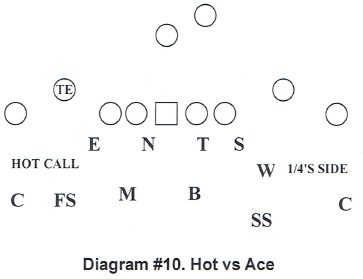 In a spread 2 X 2 formation with the back set to the field, our Will linebacker will declare in that direction. (Diagram #10) That is the sky coverage side. The twin receivers into the boundary is the "hot" side of the coverage. The free safety and corner have man-coverage on the number-1 and number-2 receivers to that side. They can play in-and-out coverage on rub patterns. The Mike linebacker has to echo the "hot" call because he has the number-3 receiver in the backfield.
In a spread 2 X 2 formation with the back set to the field, our Will linebacker will declare in that direction. (Diagram #10) That is the sky coverage side. The twin receivers into the boundary is the "hot" side of the coverage. The free safety and corner have man-coverage on the number-1 and number-2 receivers to that side. They can play in-and-out coverage on rub patterns. The Mike linebacker has to echo the "hot" call because he has the number-3 receiver in the backfield.